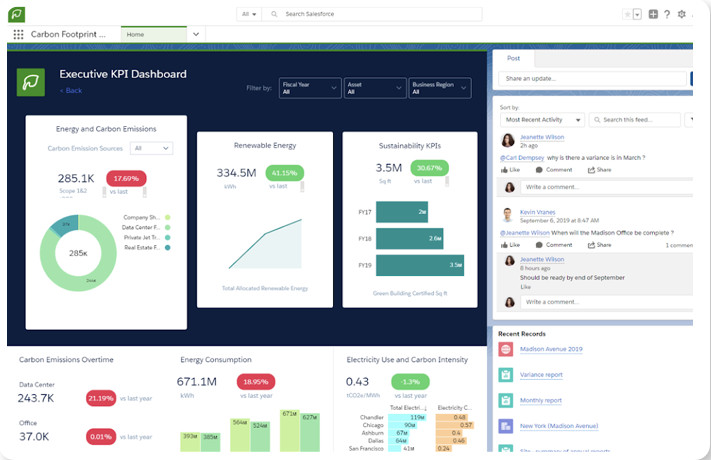
How do you make ‘sustainability’ tangible?
This is is probably one of the most frequent questions I am being asked across the breadth of people and organisations I engage with: consulting clients, the boards I advise or sit on etc..
The usual answer is – unsurprisingly – a ‘well, it depends’.
Which it evidently does.
It depends on the company, on the company culture, on their size, the product make, the service they provide, the geography they are located in. And last but not least: on budgets.
At the bottom of it all though is not ‘tangibility’, but rather the will and intent to be truly transparent and accountable.
With all that said, good case studies are extremely rare to come across.
So, when I stumbled across such a gem in one of the primary Swiss news papers, I jumped at the opportunity to summarise it for this blog.
Links to the original (German language) article can be found at the bottom.
Without further ado, let me summarise the key aspects of the case study by answering the 5WHs.
The 5HW of a sustainability case study
Who:
The company in question is Swiss Re.
Swiss Re is one of the two world’s largest reinsurance company with an estimated 39.65 billion USD in premiums in 2019.
What, Where:

Swiss Re has committed to a net zero goal by 2030 for their own operations, and a 2050 net zero goal for their Scope 3 emissions, including investments and clients.
The case study looks at
- In-house operational activities: Goals as well as measures how to translate those to tangible action at employee level.
Specifically: the 2030 overall net zero goal is complemented for example through- A 2021 a 35% net carbon reductions from flights relative to the 2018 baseline, and
- A net 2% energy use reduction relative to the 2018 baseline.
- A CO2 tax of 100 USD per ton as at writing, with an increase to 200 USD a ton by 2030
- Investment activities: ESG criteria are being rolled out across the whole portfolio.
For example:- Increase of loans for renewable energy and social infrastructure projects by 750 Million USD by 2024, and
- By 2025: a net carbon impact reduction by 35% across the whole portfolio relative to a the 2018 baseline.
- (Re-)Insurance activities: The following are locked in phase out timelines
- 2023: contracts with the most CO2 intensive (top 10%) oil and gas companies are being discontinued.
- 2030: contracts with coal companies within the OECD are being discontinued.
- 2040: contracts with all coal companies globally.
Why:

While Swiss Re does not release exact numbers on this one, the following is a publicly available:
The cost of hesitation or indeed of doing nothing
Christian Mumenthaler, Swiss Re CEO
outstrip by far the investments required
for our path to net zero.
It looks as if the answer is an easy one in the case of a reinsurance company …
How
This is where it gets truly interesting, and where the rubber hits the road when ‘making it happen’.
What does Swiss Re concretely do? How do they convert pledges into action?
The following is not an exhaustive list of all their action, but rather a few key tools and ideas taken from what has been made publicly available (reference at the end).

- In-house operational activities:
- Two employee specific dashboards:
Dashboard one: CO2 footprint generated through infrastructure and work activity items such as phone, computer, printer, energy, business travel etc.
Dashboard two: costs generated by all the above ingredients. This includes actual costs (as billed to the company) as well as a carbon price that currently is set at 100 USD a ton. - Absolute carbon cap per employee, per team, per department etc
If an employee exhausts their allocated carbon budget, no further ‘carbon spending’ is possible. Unless someone else in their own team ‘donates’ some of their carbon budget. - Budgets are tangibly affected by carbon pricing.
At the same time, the carbon price per ton sensitively affects overall team budgets, and leads to necessary discussions, cut backs and trade offs. - Bonuses are linked to the attainment of climate goals:
The overall bonus payments in Swiss Re amounted to 350 million USD in 2020. All of that money is tried also (but of course not only) to whether or not the company is on track with their carbon reduction targets.
- Two employee specific dashboards:
- Investment activities:
- In addition to the above mentioned phase out plans, an increased focus to make funds available for alternative infrastructure providers such as carbon capture and storage companies.
- further, the company as since 2017 reallocated the full 125 billion USD of assets under their management into investments with a much better risk-return profile. Across all asset classes: stocks, funds, bonds etc. .
- (Re-)Insurance activities:
- In parallel to the phase out, direct and indirect (via asset managers) engagement dialogues are being held with carbon oil, gas and carbon extractive companies. The goal of which is to convince as many of these companies to outline and implement a viable, and speedy transition plan for their business. The dialogue is particularly intensive with companies based in the developing world so as to ensure that the role they play as local employers and highly relevant contributors to well-being is whenever possible maintained (hence the somewhat longer phase out timeline for such geographies).
These dialogues are currently taking place with around 400 companies.
- In parallel to the phase out, direct and indirect (via asset managers) engagement dialogues are being held with carbon oil, gas and carbon extractive companies. The goal of which is to convince as many of these companies to outline and implement a viable, and speedy transition plan for their business. The dialogue is particularly intensive with companies based in the developing world so as to ensure that the role they play as local employers and highly relevant contributors to well-being is whenever possible maintained (hence the somewhat longer phase out timeline for such geographies).
Conclusion:
Swiss Re is no doubt a huge company.
At the same time this also means that the complexity of the issues they deal with – including how to make ‘sustainability’ tangible to their around 13’000 employees – are of rather quite intimidating proportions. And yet – they have leveraged their already existing operational data and mechanisms cleverly to align with their commitments.
The key point in all of this, to quote Vincent Ecker, Head of Environmental Management at Swiss Re:
I know that a lot of companies do not have these data easily at their disposition.
Vincent Ecker, Head of Environmental Management at Swiss Re
It took us also a fair amount of time to get there.
Fundamentally, that is just a question of technology, and is entirely solvable.
But first, and most importantly:
Senior management must decide if they are willing to create such transparency.
Further reading:
- Article in the Neue Zuercher Zeitung (NZZ), 2nd Mai 2021: ‘Wie die Swiss Re den Klimawandel bekämpft und dabei Kunden und Mitarbeiter auf Kurs bringt’ (German original; Google translated version here)
- The NZZ article as PDF (German language only)
- Swiss Re Sustainability Report 2020

